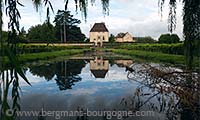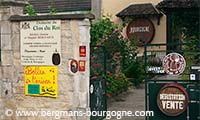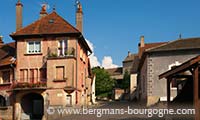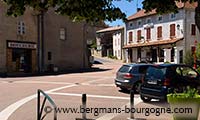
nce you arrive in the Mâconnais, the southeastern corner of Burgundy, things begin to change. The climate is slightly more southern. The architecture is a bit different. South of the Côte Chalonnaise the landscape changes. While the Côte d'Or, and to some extent the Côte Chalonnaise, run along a single slope the vineyards of the Mâconnais give the impression of being scattered all over the place. The landscape is often more dramatic and there is a large number of hills surrounded by vines.
Wine production is predominantly white. The only existing village appellations, five in total – Viré-Clessé, Pouilly-Fuissé, Pouilly-Vinzelles, Pouilly-Loché and Saint-Véran – are for white wine only. At this point there are no premier or grand crus here and the reds never make it higher up the hierarchy than regional appellations.

– The past two decades have meant a lot of improvement in this part of Burgundy, says Christophe Thibert at Domaine Thibert in Fuissé. I think the most important is that the winegrowers in the Mâconnais now know that with our terroir here we have a real potential to make great wines with our chardonnay. In the past that wasn't their aim. The wines were good, but we have a great potential here. That is why we are now in the process of trying to have some parts upgraded to premier cru.
For red wine gamay is the dominating grape variety. About three quarters of the production is gamay, the rest is pinot noir. Of the total production the Mâcon reds and rosés only account for about 16 per cent.

From north to south the Mâconnais is 50 kilometres. To the north you have the Côte Chalonnaise and in the south it borders on the Beaujolais. From an appellation point of view it not only borders on the Beaujolais, entangled with the Beaujolais is more like it. In the villages of Leynes, Chânes, Chasselas and Saint-Vérand in the very south of the Mâconnais you will find that the Beaujolais and Beaujolais-Villages appellations reach all the way into the Saône-et-Loire departement.
Apart from the five village appellations the Mâconnais area also has the three regional appellations of Mâcon, Mâcon-Villages and Mâcon + the name of one of the communes within the appellation. This is the main part of the production for the Mâconnais. The three Mâcon appellations account for an annual production twice the size of the five village appellations together. Straight Mâcon can be produced in 93 different communes throughout the Mâconnais and comes in all three colours – red, white and rosé. The production area for Mâcon-Villages is slightly more restricted – 83 communes and only for white. Another step up, when the name of a specific commune is added – Mâcon-Fuissé for instance – the number of communes is down to 72 for white and 66 for red and rosé. These are then grouped together under 27 names – Azé, Bray, Burgy, Bussières, Chaintré, Chardonnay, Charnay-lès-Mâcon, Cruzille, Davayé, Fuissé, Igé, Loché, Lugny, Mancey, Milly-Lamartine, Montbellet, Péronne, Pierreclos, Prissé, La Roche-Vineuse, Saint-Gengoux-le-National, Solutré-Pouilly, Uchizy, Vergisson, Verzé and Vinzelles. For red and rosé Fuissé, Loché, Montbellet, Solutré-Pouilly, Uchizy, Vergisson and Vinzelles cannot be used.

The climate in the Mâconnais is slightly different from that a bit further up north in the Côte d'Or. In Henri Cannard's book on Viré-Clessé Roger-Paul Dubrion describes the climate of this, the most southern part of Burgundy, as both similar and different to the Côte d'Or. The average annual rainfall is fairly low; it is 830 mm in Mâcon and 730 in Dijon. Both places have high numbers of sun hours. The annual average for Mâcon is 2000 hours, which is on par with Bordeaux but 25 per cent higher than Strasbourg.
What make the Mâconnais different are the higher temperatures. The autumns, the winters and the springs are milder. The average temperature for April to September (1950-2000) is 16.1°, not far from the figures for Lyon and Bordeaux – 16,5° and 16,6°. For the whole year the average is 11,8°. In Dijon the average is only 10,6°.
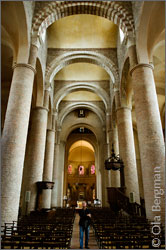 For anyone interested in church architecture the Mâconnais gives an excellent opportunity to visit a large number of Romanesque churches. There is the impressive church of Saint Philibert in Tournus from early 11th century, once belonging to the Benedictine abbey of Tournus. But there is also a Romanesque style church in almost every little village.
For anyone interested in church architecture the Mâconnais gives an excellent opportunity to visit a large number of Romanesque churches. There is the impressive church of Saint Philibert in Tournus from early 11th century, once belonging to the Benedictine abbey of Tournus. But there is also a Romanesque style church in almost every little village.
Half an hour northwest of Mâcon is Cluny, a town with a little less than 5000 inhabitants that is the home of the Cluny Abbey, a Benedictine monastery founded in 910. Towards the end of the 10th century Cluny became the acknowledged leader of western monasticism and the abbots of Cluny were statesmen on an international stage. The monastery itself became the grandest and most prestigious monastic institution in Europe. During the French revolution much of the monastery was destroyed.
Just a short drive westward from Tournus is Brancion, a medieval village with its chateau watching over the passage between the valleys of the Saône and the Grosne. Because of its strategic location this was once a place of great importance. The Duke of Burgundy, Philip the Bold, had his residence here and so did many seigneurs throughout the centuries. Today the village has been wonderfully restored and is a very nice place to visit.
Near Azé, in the hamlet of Rizerolles, are the Grottes d'Aze. These are two prehistoric caves dating back as far as 4000 centuries. Both humans and animals left traces here between 300 000 and 10 000 years ago. There are both skeletons from bears and cave lions here. In one of the two caves is an underground river, leading 1200 meters into the Mont St Romain. Guided tours (about an hour and a half long) will take you through the two long caves and it is a fascinating experience.
© 2013 Ola Bergman










